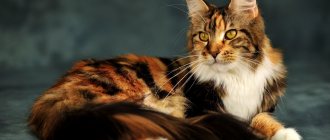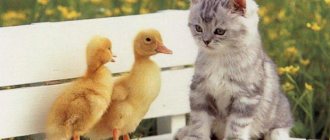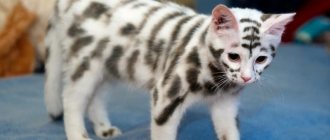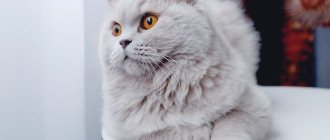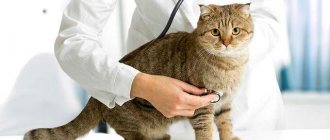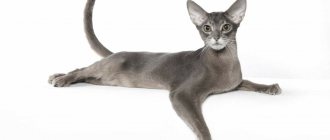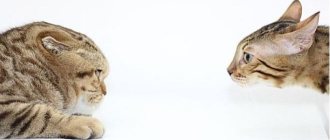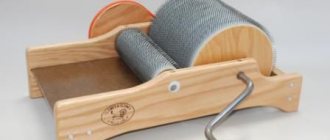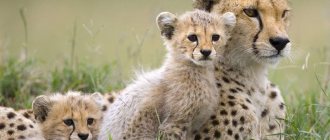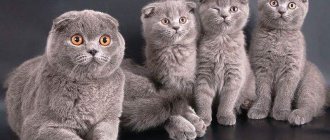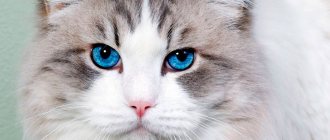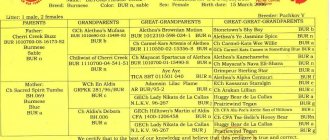British cats began to be bred en masse in 1987. Despite the fact that everyone attributes these pets to England, the pets were known throughout the world even before they appeared in this country. And if at first these beauties could boast only a single-color coat: white, gray, black or brown, today they have a large number of different shades. This is what captivates most animals.
Today there are over 25 different shades of cats. The breeders note that they are not going to stop there, so they will continue to breed British dogs whose color is mesmerizing and amazingly beautiful.
Today there are such rare combinations that are extremely rare. Such cats are especially valuable and expensive. Many people mistakenly believe that the length of the British coat directly depends on the color. This is wrong. The point is who the animals were crossed with.
Types of colors
The colors of British cats are a variety of colors. The most popular are blue and smoky pets. True, few people know that parents who have a certain color can produce different offspring at different times. How to do this is the task of the breeders.
All types of colors are usually divided into groups, which lead to the fact that cats are distinguished by:
- color dominance;
- drawings;
- pigmentation.
Next we will talk about popular and rare species, as well as their external distinctive features based on color.
Character and who is suitable for
In the cat world, red-haired Britons are considered real aristocrats. A feature of their character is English endurance and independence. These animals will not bother you with their annoying meows. They are very smart and quickly learn to use the litter box.
The cuties are clean by nature and caring for them does not take much time. The British do not allow themselves to be treated with familiarity, they do not like to sit on their laps for a long time, but at the same time they become very attached to their owners. Cats love to be cunning and consider themselves an equal member of the family, demanding appropriate respectful treatment.
They get along easily with everyone, be it children or other animals. They are patient, friendly and fearless. Even a dog can be a good buddy for plush cats.
Cats can tolerate a long time while a child plays with him, but after that the cat will let him know that he has had enough and will leave, and will not bite or scratch. Depending on their mood, they can play with pleasure and even indulge. But more often they behave rather reservedly.
Such a pet does not require a lot of attention; British cats love a calm environment and solitude. Suitable for busy people. However, a kitten should be raised from the first day it arrives in a new home, otherwise this independent pet will do everything in its own way and it will be difficult to re-educate it.
The health of British cats is quite good if the animal is fed with good food and kept in decent conditions.
Plain and smoky
The monochromatic color of a British cat implies the presence of exclusively one color without any inclusions. That is, the animal’s fur, undercoat, and skin should have only one tone. If an animal has slightly visible spots or stripes, it will no longer be classified as that variety.
Important! Solid-colored kittens after birth may have various dark spots, this is the norm. After a year, these spots go away.
Popular solid British cats are:
- white (it is believed that they were one of the very first to appear in the world);
- red;
- lilac;
- blue;
- chocolate;
- black;
- creamy.
Despite the fact that black cats are popular, in recent years the animals have been extremely rare. Breeders note that it is difficult to obtain such a shade.
Smokey Brits are not uncommon. Often these are the pets that live in many people’s homes. This shade is not difficult to obtain, so cats of the presented colors have gained wide popularity and love. In addition, the cost of animals with such fur is low, which gives everyone the opportunity to buy a four-legged friend for themselves.
Characteristics of cinnamon cats
According to breeders and owners of cats of such unusual colors, their pets have a soft and flexible character. This is also typical for shorthaired British cats, although most animals of this breed have a difficult temperament.
Cinnamon cats are calm, intelligent and even shy. Having appeared in a family, they easily adapt to the existing way of life of their owners and do not try to rebuild it to suit their habits.
Such a cat easily finds mutual understanding with other pets or becomes a companion to its owner if it turns out to be the only animal in the house.
White
White beauties are incredibly gentle and soft. The skin has a light pink color. Often these are British people with blue eyes, but in some you can see aquamarine and even multi-colored. The animals' fur is so snow-white that it resembles ice shimmering in the sun or freshly fallen snow. The color can easily be classified as cold. Some people confuse this shade with yellowish, believing that this is the norm, but this is not the case. In the case when white turns into some other color or resembles more flesh-colored, it is no longer classified as this color.
Features of genetics and mating of red British dogs
Purely red British cats are rare mainly for the reason that to guarantee the appearance of a kitten of this color, both parents must have red (orange) fur, that is, they must have the corresponding gene in their gene set.
The color of cat fur is ensured by the presence of coloring pigments (melanins), which have different sizes and shapes; they may be present in the hairs in unequal quantities:
- phaeomelanin - oblong ellipsoidal grains that give the coat a color in orange, red and yellow;
- eumelanin - round spherical particles that color hair black because they absorb almost the entire spectrum.
There are only two main genes that determine a cat’s color: red and black.
Red color in relation to black is dominant and is designated by the letter “O”, black, respectively, is “o” (not red) . The gene that is responsible for the production of these substances is located on the X chromosome and is considered linked to the sex of the animal. The color of the future offspring is determined by both parents (cat and cat), who pass one chromosome to the kittens. Males have the XY set, that is, only one X chromosome. Therefore they can be:
- o - black;
- O - orange.
XX females have two such chromosomes and more color options:
- OO - red (red);
- oo - black;
- Oo and oO - black and red (turtle).
Cats are also sometimes tortoiseshell red and black, but this occurs as a result of a gene mutation (extra X chromosome). Such individuals are usually sterile (sterile).
Video: why only cats can be tortoiseshells, but not cats
The intensity of the red hue (lightness or dilution) is determined by the diluent gene D (Dilutor). If it is present, the animal has a light cream or yellow color (dilute red). At the same time, dye pigments are rarely located in the hairs, which gives such a pale, loose tonality.
Diluted red gives a creamy coat color
It has been noticed that the gene responsible for the red color of the coat is passed on from mother to son . When crossing a red British female with a black male, only half of the offspring will be red and these will only be cats. If you breed a red cat with a black cat, then there will be no orange offspring at all (only black and tortoiseshell ones). As a result of the mating of a male with red fur and a female tortoiseshell, half of the kittens (¼ females and ¼ males) will be red. Only 25% of ginger cats will produce a black cat and a tortoiseshell cat. Parents with red fur will have babies of the same shade (red or cream).
My office neighbor has a British tortoiseshell cat. She had already become a mother several times, and the kittens in the litter came in a variety of colors. Usually gray, blue and tortoiseshell. But one time, when they took some super certified black father as their father (they paid a lot of money for the mating), a completely unexpected offspring was born. That is, half were quite expected tortoiseshell, but the other two kittens were red. One is a bright orange, and the other is a pale, dirty yellow.
Kittens in the same litter can be different colors
Black
Charcoal-colored pets are incredibly beautiful. The black shimmers mesmerizingly in the light, giving the fur coat some incredible and inimitable shade. Black Britons have been rare in recent years. This is due to a sharp change in shade at six months to one year of age. Babies that are born may be “tar”, but over time the color changes to chocolate or brown. It turns out that initially the breeders believe that they managed to acquire “little devils,” but later it turns out that these are completely different beauties.
Some black cats have chocolate or dark (close to black) undercoat in some places. It is unacceptable. Such pets look very beautiful and unusual, but the animals are already classified as two-colored and cannot in any way be called charcoal.
When buying a black cat, you need to be prepared for the fact that in the future the shade of its fur will change and your furry friend will have a different fur coat.
Chocolate
You might think that most black cats turn chocolate over time, but this is not true. Babies, whom nature has endowed with such a shade, have a deep tone in childhood, but not very saturated. The beautiful chocolate shade makes itself felt in six months. The color is so monotonous that sometimes it is impossible to describe it in words. Breeders say that the cost is affected by the depth of color. In some countries, chocolate Britons are also called chestnut or havanna.
Blue
Many people like British blue cats. At the same time, some confuse blue with a silver tint, which is sometimes present. In purebred animals, lightening of the undercoat hairs is allowed, but only by one tone. As for the fur coat itself, there should not be even a hint of any inclusions or discrepancies from the overall color.
People call blue Britons smoky or gray, although, of course, this is not an entirely correct definition. Almost all babies have stains of other shades on their fur coats, which gradually disappear over time. Those pets whose blue color is close to gray are considered elite. This is an incredibly beautiful shade and is rare.
Some unscrupulous sellers claim that blue British cats must have orange eyes. In fact, the majority of handsome people are born blue-eyed, and only over time the eye color acquires a shade that remains for life. And it's not always orange. In some representatives, one eye may be one way, and the other completely different. Therefore, you need to judge solely by the saturation of the wool.
History of the origin of the breed
Historians are convinced that this cat breed was one of the first to appear. Moreover, there is information that animals were brought to Great Britain by the Romans. In ancient images you can see short-haired cream cats, as well as animals whose fur has other shades.
There is another version, according to which the Sacred Beauties came to England from France. The inhabitants of this country always took cats with them on voyages so that they would not allow rats and mice to eat the supplies. When stopping at British ports, the animals accidentally ended up on land.
Believing or not these theories is up to each person. One thing you can’t argue with is that snow-white fluffies are actually incredibly beautiful and gentle.
Lilac
Lilac representatives are sometimes also represented as cream British. This is due to the color, which combines soft pink and blue. Words cannot describe the shade because it can vary and be different from one litter to another. Babies, immediately after birth, resemble pink piglets, their fur is so bright. As pets grow older, their fur coat becomes blue.
At the same time, animals owe their additional beauty to their undercoat, which is usually a tone and a half lighter than the main color. The eyes of representatives of this breed can only be amber or copper. If this is not the case, then it will not be possible to classify the animal as a lilac species. Many people want to have such pets, but the presented tone is very rare. Getting it is luck. Breeders have been struggling with this for years and in the end nothing works out.
Ideal British Shorthair eye color based on coat color
Speaking about the colors of the British Shorthair breed, it is worth mentioning the shade of the eyes in each category, as this is very important for the correct assessment of the animal.
Below is a table of the correspondence of the shade of the cornea of the British Shorthair's eyes to the fur color.
| Eye color | Wool shade |
| Orange, amber, gold | Black and blue. |
| Chocolate and lilac. | |
| Cinnamon (cinnamon) and fawn. | |
| Red and cream. | |
| Blue | Color-point colors. |
| Green, brown, orange, amber, gold | Silver tabby. |
| Emerald | Silver. |
| Golden smoke. | |
| Copper shaded. | |
| Green, blue, orange, colorful | White. |
Eye color is determined by the amount of pigment in the iris. If there is a lot of it, the cornea will have an orange tint, while in the complete absence it will have a blue tint. Green and yellow tones lie somewhere in the middle of these two extremes.
Most domestic cats have yellow or green eyes, which fall in the middle of the spectrum. Eye color in British Shorthairs must be actively and selectively bred to maintain it at the very end of the color scale.
A dilution program that does not take eye color into account ultimately results in a dilution of the desired shade, with all corneal tones shifting toward the middle of the spectrum and ending up yellow or green.
Look at the handsome blue-eyed Briton Kobe:
British Blue eye color
Blue British Shorthairs have been bred widely and over a long period of time, so the characteristics of the British Blue color have a fantastic opportunity for development.
The result is many blue British Shorthair cats with a fantastic orange eye tint, although this is a very difficult color to breed.
Blue color with yellow eyes
Shorthair British Chocolate Lilac
Chocolate and lilac colors have recently been introduced in this ancient breed.
Bicolor with base lilac and dark orange eyes
As a result, it is much more difficult to find chocolate or lilac British Shorthairs with exceptional orange eye color: most "chocolate" and "lilac" have irises of yellow or amber shades. Although some breeders managed to get incredibly orange eyes from lilac shades of color.
Cinnamon and fawn British Shorthair color
Cinnamon and fawn coat colors have appeared more recently, and the eye color of these animals is similar to the shade of “chocolate” and “lilac”, but less developed and not as rich.
Color cinnamon
Color Point British Shorthair
For breeders of English cats of this color, the goal is to have the eyes as blue as possible and this is a very difficult task.
Color point kitten with blue eyes
Most colorpoints have silver-blue eyes. They are incredibly beautiful in their own right, and many people actually prefer silver tones over bright blue.
For show judges, however, preference is given to colorpoints with bright blue corneas. They have no pigment at all - they are not actually blue, but pure.
Silver irises have very little pigment.
Professional breeding and eye color of the British Shorthair
Ultimately the eye color that is preferred in an animal is a personal choice of the breeder and will obviously not affect the purity and beauty of the breed.
British tabby cats
If the goal of purchasing a British cat is to participate in competitions and exhibitions, then you need to choose a good nursery with a breeder who understands genetics and has some breeding experience.
A good experienced breeder will be able to help the client choose their most suitable kitten.
British Shorthair kitten - correct eye coloring
All British Shorthair kittens are born with blue eyes. Gradually, as they grow older, they acquire their true color.
This transition begins when the cubs are about 6-8 weeks old and continues until they are about 2 years old, when they finally reach their full colors.
Blue kitten
For example, a blue British Shorthair kitten is born with blue eyes, and these will then change color to a variety of shades, including dirty brown and green, before the color is fully developed.
It should be remembered that no matter what the final eye color is, the kitten will always have blue eyes.
Eye color and choice of matings
Breeders should pay attention to the animal's eye color when choosing a breeding pair, especially if these matings occur between cats with different shades of irises.
Torti or tortoiseshell color
Tabby
Golden chinchilla
Tabby
Golden chinchilla
White color
Some breeders never mix cats with different eye colors together. However, there are often features that you can have in one color line that you would like to present in another shade type.
For example, British Blues are often very stubborn cats, and a breeder may want to introduce a little more of this trait into a Color Point or Silver Tabby line.
Tabby
Likewise, breeding between colors can be very helpful in maintaining genetic diversity within them, ensuring that there are enough cats with a wide range of patterns to continue that type in a healthy way.
It is known, for example, that silver tabbies need more genetic diversity.
Its good-natured appearance and relatively calm temperament make the British Shorthair a frequent media star, most notably as the inspiration for John Tenniel's famous illustration of the "Cheshire Cat" in Alice in Wonderland.
The Cat Fanciers' Association profile reads: "When ingenuousness is observed, the British Shorthair is suitably embarrassed, quickly appearing with a 'Cheshire Cat smile'."
Faun
Some people believe that the fawn is a cream-colored British cat, but this is incorrect. Newborns resemble small fawns with a light pink-cream shade of fur. Such representatives are extremely rare, which directly affects their very high cost. Experienced breeders recommend that when purchasing such cats, if you still manage to find them, you must ask for exactly this color and no other color to be included in the passport. The reason is that the presented shade can be determined solely by DNA analysis. If the seller refuses to enter the color into the passport, it means that they are trying to sell the wrong animal under the guise of an elite and expensive animal.
Shaded gold and silver color
Many chocolate, black and purple animals have a silver tint. This covers the pet's paws, belly, collar and chest.
As for the golden color or copper color, as breeders also say, it is rare. In this case, the coat is darker at the base, and at the end the hairs appear golden. It is impossible to confuse such pets with others, if only because they have a black tip of their tail, paw pads, and also eyeliner around their eyes. People call this type of cat the domestic chinchilla or the ticked British cat. This color of a British cat is not very rare, because breeders know well how to get it.
Anomalous features acceptable for British red dogs
A clean and even red shade of fur, as required by the breed, is extremely rare, because it is difficult to achieve. At shows, experts often give British redheads some slack, as opposed to other solid colors (such as chocolate). Much more often, animals have uneven coloring, so the tip of the tail is almost always lightened. It is allowed to have fuzzy and unexpressed shadows, some vague hint of the drawing. In addition, faint tabby markings on the face and uncirculated darker stripes on the feet are permitted.
The standard allows residual tabby markings on the face
In kittens born with a clear tabby color, the pattern becomes less pronounced with age and can easily be mistaken for an even, monochromatic color.
Tabby
The British tabby is some kind of color mix, since the animals can have a golden or silver background, and can resemble a color point shade. On the body of adult animals there are often bright stripes or spots, like a leopard. Babies are brindle or spotted. This is not a deviation from the norm.
Spotted Britons are usually confused with other breeds, but they are distinguished by their eye color, as well as the shape of their ears and habits. In addition, the British have the most dense wool that representatives of the presented breed can boast of.
Pet health
The only specific disease characteristic of white British cats is genetically determined deafness. Otherwise, these cats do not differ from their counterparts with fur of a different color. They all have good health and good immunity.
But they are prone to obesity, polycystic kidney disease, hemophilia, and hypertrophic cardiomyopathy. Veterinarians often encounter increased formation of tartar, which is also genetically determined.
In order to minimize possible risks associated with the development of hereditary diseases in the British, inbreeding should be avoided and parental pairs should be carefully selected for breeding work.
Tortoiseshell
Tortoiseshell cats must have cream, black and red spots on their faces. Many people believe that a British tortoiseshell kitten is a tabby when it is a baby, but this is not the case. Any patterns indicate a crossbreed. Our four-legged friends have orange or copper eyes.
Tortoiseshell cats usually have color combinations such as:
- Red and cream.
- Brown, black and chocolate (this is already a tricolor cat, but it still belongs to these representatives).
- Blue and purple.
“Turtles” are much more feminine. Moreover, breeders note that only females should have this shade. If a tortoiseshell cat is born, then this is, firstly, a genetic error, and secondly, the animal is almost always infertile. For this reason, many give up the desire to get a similar color of animals, because it is labor-intensive work, and it does not always end successfully.
It is better to get a red British cat or a peach one, but be confident in them than to take risks.
Cat colors: what they are and how they are bred
Color, which is considered the most important characteristic of the breed, is the color of the animal’s coat and various patterns on the skin (spots, stripes, stains, etc.). In the wild, individuals of the same species have almost the same color. Cats, through the process of domestication and selection, have acquired a huge number of coat color options.
British cats can have different colors
A fairly small number of basic genes (solid color, diluents, lighteners, patterns, etc.) are responsible for this diversity, but when composed in different combinations they give an innumerable number of colors. New colors are developed taking into account the genes needed for selection, both dominant (suppressing) and recessive (suppressed), working with which, a competent breeder systematically achieves a new shade.
Marbled or wild
Marble color is a silver or white coat with dark stripes on top. Often the drawings are large in size. Very often, representatives of this color are called “snow leopards.” Some animals have stripes so uneven and large that it looks like the cat is two-colored. In recent years, not only light-colored cats have become marbled. The main tone can be chocolate, black, blue. On the “golden chinchilla” you can even find similar spots.
Wang
Animals belonging to a breed with this color have several subspecies, according to which they differ:
- We are talking about van - the main color is white.
- Bicolor - an animal with large white spots on its fur.
- Miteda - representatives with white paws, as well as a light-colored stripe from the chin to the groin.
- Tricolor is a tortoiseshell color with three shades, which necessarily includes white.
- Harlequin - a large white spot on the fur.
That is, when talking about van, they mean different types of shades that are included in the general group. At the same time, the main color is always white.
Important! Kittens with the meted color are not officially allowed to be bred. This color will not be included in the van group and will not be listed in the passport.
The situation with the shade is very problematic, because it exists, everyone knows about it, but it has not yet been officially recognized. Although such animals look beautiful and unusual.
The British - who are they?
Britons are one of the most popular domestic cats in Europe. The breed went through a difficult development path before acquiring its modern appearance. Today they are large (the average weight of a cat is six kilograms), powerful and stocky animals with a large round head, expressive eyes and small ears. Particular attention is drawn to the luxurious fur with its huge variety of colors and patterns: the famous “plush” for short-haired ones and thick, fluffy for long-haired ones.
According to legend, the distant ancestors of modern Britons were brought to Foggy Albion about two thousand years ago by the Romans. It can be assumed that those cats were predominantly wild in color - tabby, but have since changed greatly, crossing with local stock and adapting to the cold climate.
Video: everything about the British cat breed
Whiskas
There is no such breed with the Whiskas color. The animals received this name among the people. The reason is that British people of marquel or brindle color (these are the official names) very often starred in advertisements for animal food, hence the origin of whiskey. The main coat of quadrupeds is silver, but there are also gray or black stripes on the back, their number is always three. In addition, representatives of the breed have only yellow-orange eyes. Animals with rich dark stripes are prized.
Whiskeys are incredibly beautiful at any age. Babies have slightly lighter fur than adults.
No matter what breed people pay attention to - be it a British shorthair cat with a fawn color or a longhaired chocolate cat, they will not regret it. Each breed with its color is a special delight for the eye, which will be a devoted purr for its owner.
Did you like the article?
British white cat care
White British kittens must be litter trained from childhood. They remember very well that they need to go to their toilet, so they don’t shit in the wrong places. To avoid problems, from a young age you need to examine your cats eyes, ears, teeth, and also brush them regularly. In the morning, the four-legged eyes may turn sour, so you will need to carefully wipe them with a damp cloth.
Sometimes cats tear their fur. This is due to the fact that lumps collect in the stomach. To eliminate the problem, you need to give the animals a special paste or food from time to time.
British white cats can boast of luxurious fur; in order for it to remain that way, a number of rules must be followed:
- Bath the animal several times a year (maximum 4 times) using special shampoos.
- After bathing, be sure to dry the coat with a hairdryer, as if styling.
- Once a week, brush your pet with a soft brush that does not tear the hairs.
- Coughed clumps should be cut off immediately.
